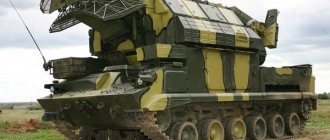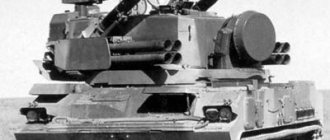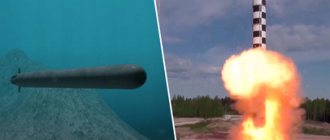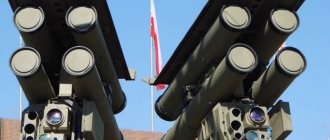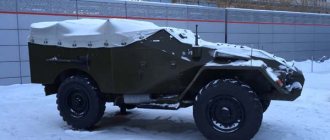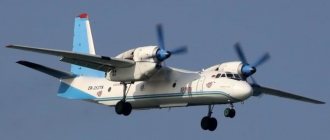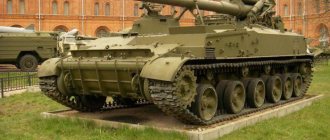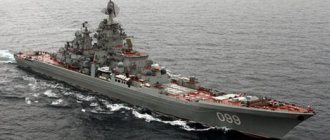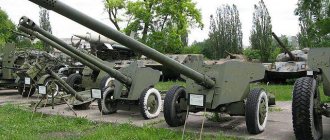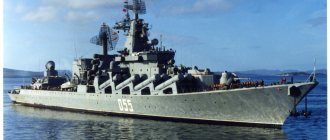Characteristics of the self-propelled air defense system "Strela-10" 9K35
A country:USSRType:Anti-aircraft missile systemDate of issue:1976/1989Calculation:3 personsCaliber:9M37 missiles (speed: 517 m/s, missile mass 40 kg, warhead 3 kg) / 9M333 missiles (speed: 517 m/s, missile mass 42 kg, warhead 5 kg)Length:6.45 mWidth:2.85 mWeight:12.3 tonsRate of fire:Not applicableFiring distance:Range: 800 m - 5 km, height: 25 m - 3.5 km / Range: 800 m - 5 km, height: 10 m - 3.5 kmInitial projectile speed:See aboveAmmunition:8 missiles (probability of hitting the target with the 1st missile: 0.1-0.5) / 8 missiles (probability of hitting the target with the 1st missile: 0.3-0.6)
The data is given for modifications “Strela-10SV” / “Strela-10M3”
Content
- 1 History of creation
- 2 Composition 2.1 Combat vehicle 9A35
- 2.2 9M37 missiles
- 2.3 Zone assessment equipment 9С86 (АОЗ)
- 3.1 9K35M "Strela-10M"
- 5.1 Unrecognized republics
The history of the creation of the self-propelled anti-aircraft missile system "Strela-10"
The development of the Strela-10 9K35 regimental anti-aircraft missile system (NATO code: Gopher) began on July 24, 1969 (Precision Engineering Design Bureau), and was a further development of the earlier 9K31 Strela-1 air defense system . Only by 1976 did the new Strela manage to successfully complete military tests and be accepted into service. However, as practice has shown, such long torment was not in vain - Strela-10 became a first-class short-range anti-aircraft missile system and eventually grew into a whole family of similar vehicles, which are still in service with about 20 countries (mainly the countries of the former USSR and the Warsaw Pact).
Drawing of the combat vehicle of the self-propelled anti-aircraft missile system "Strela-10" 9K35
The main element of the Strela-10 9K35 air defense system is a combat vehicle created on the basis of the MT-LB army multi-purpose tractor . Its armament: 8 anti-aircraft missiles (4 in the launcher, 4 additional in the hull) and a 7.62 mm PKT machine gun for defense. The chassis was chosen extremely well: the “all-terrain” chassis from MT-LB has a very low specific ground pressure, which allows the Strela-10 to move through off-road terrain, swamps, virgin snow, sandy terrain, and even swim across water obstacles. An important factor is the high smoothness of movement, which ensures high shooting accuracy on the move.
The anti-aircraft platoon of the Strela-10 complex consists of four combat vehicles.
Self-propelled anti-aircraft missile system "Strela-10" 9K35. The combat vehicle searches for targets
Excerpt characterizing Strela-1
- Take it, put it down, it’s all the same! – someone’s voice shouted. Another time they took him by the shoulders and put him on a stretcher. - Oh my god! My God! What is this?.. Belly! This is the end! Oh my god! – voices were heard between the officers. “It buzzed just past my ear,” said the adjutant. The men, having adjusted the stretcher on their shoulders, hastily set off along the path they had trodden to the dressing station. - Keep up... Eh!.. man! - the officer shouted, stopping the men walking unevenly and shaking the stretcher by their shoulders. “Make adjustments, or something, Khvedor, Khvedor,” said the man in front. “That’s it, it’s important,” the one behind him said joyfully, hitting him in the leg. - Your Excellency? A? Prince? – Timokhin ran up and said in a trembling voice, looking into the stretcher. Prince Andrei opened his eyes and looked from behind the stretcher, into which his head was deeply buried, at the one who was speaking, and again lowered his eyelids. The militia brought Prince Andrei to the forest where the trucks were parked and where there was a dressing station. The dressing station consisted of three tents spread out with folded floors on the edge of a birch forest. There were wagons and horses in the birch forest. The horses in the ridges were eating oats, and sparrows flew to them and picked up the spilled grains. The crows, sensing blood, cawing impatiently, flew over the birch trees. Around the tents, with more than two acres of space, lay, sat, and stood bloodied people in various clothes. Around the wounded, with sad and attentive faces, stood crowds of soldier porters, whom the officers in charge of order vainly drove away from this place. Without listening to the officers, the soldiers stood leaning on the stretcher and looked intently, as if trying to understand the difficult meaning of the spectacle, at what was happening in front of them. Loud, angry screams and pitiful groans were heard from the tents. Occasionally a paramedic would run out to fetch water and point out those who needed to be brought in. The wounded, waiting for their turn at the tent, wheezed, moaned, cried, screamed, cursed, and asked for vodka. Some were delirious. Prince Andrei, as a regimental commander, walking through the unbandaged wounded, was carried closer to one of the tents and stopped, awaiting orders. Prince Andrei opened his eyes and for a long time could not understand what was happening around him. The meadow, wormwood, arable land, the black spinning ball and his passionate outburst of love for life came back to him. Two steps away from him, speaking loudly and drawing everyone's attention to himself, stood, leaning on a branch and with his head tied, a tall, handsome, black-haired non-commissioned officer. He was wounded in the head and leg by bullets. A crowd of wounded and bearers gathered around him, eagerly listening to his speech. “We just fucked him up, he abandoned everything, they took the king himself!” – the soldier shouted, his black, hot eyes shining and looking around him. “If only the Lezers had come that very time, his title, my brother, would be gone, so I’m telling you the truth...” Prince Andrei, like everyone else around the narrator, looked at him with a brilliant gaze and felt a comforting feeling. “But doesn’t it matter now,” he thought. - What will happen there and what happened here? Why was I so sorry to part with my life? There was something in this life that I didn’t understand and don’t understand.” One of the doctors, in a bloody apron and with bloody small hands, in one of which he held a cigar between his little finger and thumb (so as not to stain it), came out of the tent. This doctor raised his head and began to look around, but above the wounded. He obviously wanted to rest a little. After moving his head to the right and left for a while, he sighed and lowered his eyes. “Well, now,” he said in response to the words of the paramedic, who pointed him to Prince Andrei, and ordered him to be carried into the tent. There was a murmur from the crowd of waiting wounded. “Apparently, the gentlemen will live alone in the next world,” said one. Prince Andrei was carried in and laid on a newly cleaned table, from which the paramedic was rinsing something. Prince Andrei could not make out exactly what was in the tent. Piteous moans from different sides, excruciating pain in the thigh, stomach and back entertained him. Everything that he saw around him merged for him into one general impression of a naked, bloody human body, which seemed to fill the entire low tent, just as a few weeks ago on this hot August day the same body filled the dirty pond along the Smolensk road . Yes, it was that same body, that same chair a canon [fodder for cannons], the sight of which even then, as if predicting what would happen now, aroused horror in him. There were three tables in the tent. Two were occupied, and Prince Andrei was placed on the third. He was left alone for some time, and he involuntarily saw what was happening on the other two tables. On the nearby table sat a Tatar, probably a Cossack, judging by his uniform thrown nearby. Four soldiers held him. The bespectacled doctor was cutting something into his brown, muscular back. “Uh, uh, uh!..” it was as if the Tatar was grunting, and suddenly, raising his high-cheekboned, black, snub-nosed face, baring his white teeth, he began to tear, twitch and squeal with a piercing, ringing, drawn-out squeal. On another table, around which a lot of people were crowding, a large, plump man with his head thrown back lay on his back (the curly hair, its color and the shape of the head seemed strangely familiar to Prince Andrei). Several paramedics leaned on this man's chest and held him. The large, white, plump leg twitched quickly and frequently, without ceasing, with feverish tremors. This man was sobbing convulsively and choking. Two doctors silently - one was pale and trembling - were doing something on the other, red leg of this man. Having dealt with the Tatar, on whom an overcoat had been thrown, the doctor in glasses, wiping his hands, approached Prince Andrei. He looked into the face of Prince Andrei and hastily turned away. - Undress! What are you standing for? – he shouted angrily at the paramedics. Prince Andrei remembered his very first distant childhood, when the paramedic, with his hasty, rolled-up hands, unbuttoned his buttons and took off his dress. The doctor bent low over the wound, felt it and sighed heavily. Then he made a sign to someone. And the excruciating pain inside the abdomen made Prince Andrei lose consciousness. When he woke up, the broken thigh bones had been removed, chunks of flesh had been cut off, and the wound had been bandaged. They threw water in his face. As soon as Prince Andrei opened his eyes, the doctor bent over him, silently kissed him on the lips and hurriedly walked away. After suffering, Prince Andrei felt a bliss that he had not experienced for a long time. All the best, happiest moments in his life, especially his earliest childhood, when they undressed him and put him in his crib, when the nanny sang over him, lulling him to sleep, when, burying his head in the pillows, he felt happy with the sheer consciousness of life - he imagined to the imagination not even as the past, but as reality. Doctors were fussing around the wounded man, the outline of whose head seemed familiar to Prince Andrei; they lifted him up and calmed him down. – Show me... Ooooh! O! oooooh! – one could hear his groan, interrupted by sobs, frightened and resigned to suffering. Listening to these moans, Prince Andrei wanted to cry. Was it because he was dying without glory, was it because he was sorry to part with his life, was it because of these irrevocable childhood memories, was it because he suffered, that others suffered, and this man moaned so pitifully in front of him, but he wanted to cry childish, kind, almost joyful tears. The wounded man was shown a severed leg in a boot with dried blood. - ABOUT! Ooooh! - he sobbed like a woman. The doctor, standing in front of the wounded man, blocking his face, moved away. - My God! What is this? Why is he here? - Prince Andrei said to himself. In the unfortunate, sobbing, exhausted man, whose leg had just been taken away, he recognized Anatoly Kuragin. They held Anatole in their arms and offered him water in a glass, the edge of which he could not catch with his trembling, swollen lips. Anatole was sobbing heavily. “Yes, it’s him; “Yes, this man is somehow closely and deeply connected with me,” thought Prince Andrei, not yet clearly understanding what was in front of him. – What is the connection of this person with my childhood, with my life? - he asked himself, not finding an answer. And suddenly a new, unexpected memory from the world of childhood, pure and loving, presented itself to Prince Andrei. He remembered Natasha as he had seen her for the first time at the ball in 1810, with a thin neck and thin arms, with a frightened, happy face ready for delight, and love and tenderness for her, even more vivid and stronger than ever, awoke in his soul. He now remembered the connection that existed between him and this man, who, through the tears that filled his swollen eyes, looked dully at him. Prince Andrei remembered everything, and enthusiastic pity and love for this man filled his happy heart. Prince Andrei could no longer hold on and began to cry tender, loving tears over people, over himself and over them and his delusions. “Compassion, love for brothers, for those who love, love for those who hate us, love for enemies - yes, that love that God preached on earth, which Princess Marya taught me and which I did not understand; That’s why I felt sorry for life, that’s what was still left for me if I were alive. But now it's too late. I know it!" The terrible sight of the battlefield, covered with corpses and wounded, combined with the heaviness of the head and with the news of the killed and wounded twenty familiar generals and with the awareness of the powerlessness of his previously strong hand, made an unexpected impression on Napoleon, who usually loved to look at the dead and wounded, thereby testing his mental strength (as he thought). On this day, the terrible sight of the battlefield defeated the spiritual strength in which he believed his merit and greatness. He hastily left the battlefield and returned to the Shevardinsky mound. Yellow, swollen, heavy, with dull eyes, a red nose and a hoarse voice, he sat on a folding chair, involuntarily listening to the sounds of gunfire and not raising his eyes. With painful melancholy he awaited the end of that matter, which he considered himself to be the cause of, but which he could not stop. Personal human feeling for a short moment took precedence over that artificial ghost of life that he had served for so long. He endured the suffering and death that he saw on the battlefield. The heaviness of his head and chest reminded him of the possibility of suffering and death for himself. At that moment he did not want Moscow, victory, or glory for himself. (What more glory did he need?) The only thing he wanted now was rest, peace and freedom. But when he was at Semenovskaya Heights, the chief of artillery suggested that he place several batteries at these heights in order to intensify the fire on the Russian troops crowded in front of Knyazkov. Napoleon agreed and ordered news to be brought to him about what effect these batteries would produce.
Design of the self-propelled anti-aircraft missile system "Strela-10"
As already noted, the basis of the Strela-10 air defense system is the body of the MT-LB multi-purpose tractor, all-welded and sealed, made of rolled sheets of steel armor. Reservation provides protection from bullets and shrapnel.
The power plant of the combat vehicle is equipped with a V-shaped eight-cylinder diesel engine YaMZ-238V with a power of 240 hp. The engine power system includes four fuel tanks with a total capacity of 520 liters.
The transmission is mechanical, stepped, includes a six-speed gearbox and a two-stage planetary rotation mechanism.
The chassis includes six single-pitch road wheels with external shock absorption on board. Guide wheels with mud cleaners are located at the rear, and double pinion drive wheels are located at the front. The suspension of the road wheels is individual torsion bar, with hydraulic telescopic shock absorbers on two pairs of outer road wheels on each side. On water, the machine is driven by rewinding tracks.
Combat vehicles of the Strela-10 complex of all modifications were produced by the Saratov Aggregate Plant.
The fire is carried out by the Strela-10 9K35 self-propelled anti-aircraft missile system.
Operators[ | ]
Operators of the Strela-10 air defense missile system
Play media file
9K35 "Strela-10" air defense system during exercises of the 80th motorized rifle brigade in the Arctic. March 30, 2020.
Play media file
9K35M "Strela-10M" air defense system during a training exercise for anti-aircraft gunners of the 36th Combined Arms Army at the Telemba training ground in Buryatia. April 3, 2020.
- Azerbaijan - 54 9Q35 as of 2020[16]
- Angola - 10 9K35, assessed as not combat-ready, as of 2020[17]
- Belarus - a certain amount of 9K35 as of 2018[18]
- Bosnia and Herzegovina - 1 9K35M3 as of 2018[19]
- Georgia - a certain amount of 9K35M, as of 2018[20]
- India - 250 9K35 as of 2020[21]
- Jordan - 92 9K35 as of 2020[22]
- Kazakhstan - 50 9Q35 as of 2020[23]
- DPRK: DPRK Ground Forces - a number of 9K35 as of 2020[24]
- North Korean Air Force - some 9K35 as of 2020[25]
- Ground forces - 400 9K35M3 as of 2018[27]
Unrecognized republics[ | ]
- Donetsk People's Republic - a number of 9K35 as of 2020[37]
- Lugansk People's Republic - a certain number of 9K35 as of 2020[37]
Status unknown[ | ]
- Armenia - 48 9K35 as of 2020[38]
- Afghanistan - some SA-13 Gophers, as of 2010[39]
- Yemen: Yemen Ground Forces - some 9K35 as of 2012[40]
- Yemen's air defense forces - a number of 9K35 as of 2012[40]
Unrecognized and partially recognized[ | ]
- Republic of Abkhazia - several 9K35 as of 2007[42]
- South Ossetia - several 9K35 as of 2007[42]
Notes[ | ]
- Tikhonov, T.1, 2010, p. 197.
- Tikhonov, T.2, 2010, p. 369.
- Tikhonov, T.2, 2010, p. 191.
- Tikhonov, T.2, 2010, p. 160.
- Tikhonov, T.2, 2010, p. 448.
- ↑ 1 2 3 4 5 6 7 8 9 10
“Strela-10” (9K35, SA-13, Gopher), anti-aircraft missile system
(unspecified)
(inaccessible link). Retrieved October 13, 2010. Archived July 15, 2010. - Rocket weapons. Anti-aircraft missile systems. 9K35 Strela-10 (unspecified)
(inaccessible link). Retrieved October 13, 2010. Archived March 13, 2010. - [www.kbtochmash.ru/productions-service/defence/Strela-10M4.html Anti-aircraft missile system "Strela-10M4"] (Russian). KBTochmash
. Retrieved October 7, 2020. - NPO "High-Precision Complexes": Strela-10M4 (unspecified)
(inaccessible link). Retrieved July 25, 2014. Archived July 27, 2014. - Short-range air defense system "Strela-10T"
- A-10 Combat Losses in Desert Storm (unspecified)
(unavailable link). Retrieved July 14, 2014. Archived April 28, 2020. - The MH17 tragedy as a result of escalation (Russian). bellingcat (October 11, 2016). Retrieved May 7, 2020.
- The Military Balance 2020. - P. 491.
- Ministry of Defense: the real targets of the US strike on Syria were military facilities (Russian), TASS
. Retrieved April 16, 2020. - The Pentagon declared the ineffectiveness of Syrian air defense // Kommersant
- The Military Balance 2020. - P. 183.
- The Military Balance 2020. - P. 446.
- The Military Balance 2020. - P. 186.
- The Military Balance 2020. - P. 87.
- The Military Balance 2020. - P. 187.
- The Military Balance 2020. - P. 262.
- The Military Balance 2020. - P. 343.
- The Military Balance 2020. - P. 189.
- The Military Balance 2020. - P. 276.
- The Military Balance 2020. - P. 277.
- The Military Balance 2020. - P. 401.
- The Military Balance 2020. - P. 194.
- The Military Balance 2020. - P. 194.
- The Russian Airborne Forces received more than 30 modernized Strela-10MN air defense systems | RIA News
- The Military Balance 2020. - P. 127.
- The Military Balance 2020. - P. 143.
- The Military Balance 2020. - P. 362.
- The Military Balance 2020. - P. 146.
- The Military Balance 2020. - P. 208.
- The Military Balance 2020. - P. 210.
- The Military Balance 2020. - P. 95.
- ↑ 12
The Military Balance 2020. - P. 214. - Alexander Khramchikhin.
Outpost with questions // Military-industrial courier: Newspaper. — 2016. — March 9 (No. 9(624)). — ISSN 1729-3928. - The Military Balance 2010. - P. 356.
- ↑ 12
The Military Balance 2012. - P. 355. - The Military Balance 2012. - P. 337.
- ↑ 12
Why Georgia will lose the future war (Russian). Segodnya.ru. Retrieved March 30, 2013. Archived April 17, 2013.
